#classes by deepak jain
Explore tagged Tumblr posts
Text
Top 10 Interior Designers in Indore: Transforming Spaces with Creativity

Indore, the heart of Madhya Pradesh, is a city that beautifully blends tradition with modernity. Whether you're looking to renovate your home, office, or commercial space, the city's top interior designers offer innovative solutions tailored to various aesthetic preferences. Here’s a curated list of the top 10 interior designers in Indore, ensuring elegance, functionality, and creativity in every project.
1. Create and Design
Founded by: Neha Khandelwal (2012) Create and Design is one of Indore’s most sought-after interior design firms, known for its modern and innovative approach. Specializing in residential and commercial interiors, the firm focuses on blending elegance with functionality. Whether you're looking for minimalistic, contemporary, or luxurious designs, they craft spaces that reflect individual personalities.
2. Saku – The Studio
Founded by: Manasvi Khedawdia (2019) Saku is a multidisciplinary studio offering architecture, construction, and interior design services. In a short span, they have carved a niche for themselves with their innovative designs and holistic approach to transforming spaces.
3. Design Studio X
Design Studio X is known for its modern and functional designs that cater to residential, commercial, and hospitality sectors. Their unique approach ensures aesthetically pleasing yet highly practical interiors.
4. Ankur & Sarvesh
Founded by: Ankur Jindal & Sarvesh Jain (2007) With over 15 years of experience, Ankur & Sarvesh are known for creating luxurious interiors with a perfect blend of contemporary and traditional styles. They specialize in high-end residential and commercial projects.
5. Extreme Design Sandeep Thakur Studio
Founded by: Sandeep & Mayank Thakur With 30+ years of experience, this studio excels in designing bespoke residential and commercial interiors. Their projects reflect a unique blend of heritage and modern aesthetics.
6. Morpheus Design Studio
Morpheus Design Studio specializes in high-end architecture and interior design services. They focus on creating captivating, stylish, and functional interiors for residential and commercial spaces.
7. Design Brix
Design Brix is known for its creative and responsive design solutions that cater to both residential and commercial projects. Their focus is on sustainable and aesthetically appealing interiors.
8. Classic Décor
Classic Décor offers simple yet inventive and elegant designs, making them a preferred choice for residential and commercial projects. Their unique approach ensures personalized and aesthetically pleasing spaces.
9. Environmental Design Consultants
This firm specializes in creative interior solutions that balance human needs, environmental sustainability, and artistic elements. They work on residential, commercial, and institutional projects.
10. Deepak + Kavita Design Studio
Founded in: 2010 Deepak + Kavita Design Studio is a full-service architecture and interior design firm specializing in residential, commercial, and hospitality interiors. Their unique style and expertise make them one of the leading firms in Indore.
Conclusion
Whether you're searching for a luxurious, modern, minimalistic, or traditional interior design approach, these top 10 firms in Indore offer world-class services. Create and Design, in particular, stands out for its personalized and stylish transformations. If you’re looking to elevate your space, consult these expert designers and bring your vision to life.
Let us know which interior designer in Indore inspired you the most!
0 notes
Text
The National UN Volunteers-India
AVMEMS Jawanga’s Students Shine at Western India Science Fair District Level Competition
Geedam, Dantewada, Chhattisgarh, 30 September 2024: Students Nitesh Madvi and Aayush Jain from Aastha Vidya Mandir English Medium School, Education City Jawanga, secured first and third places respectively in the Western India Science Fair District Level Competition. The winners were awarded gold and bronze medals along with certificates. These district-level winners will now showcase their talents at the zone-level science exhibition.
The Dantewada District Administration and School Education Department, Government of Chhattisgarh, organized the District Level Children’s Science Exhibition and Western India Science Fair at Swami Atmanand Government Excellent Hindi Medium School, Dantewada, on 26 September 2024. The main theme of the exhibition was “Science & Technology for Sustainable Future,” with sub-topics including food health & hygiene, communication & transportation, natural farming, disaster management, waste management, and resource management.
𝗔𝗰𝗵𝗶𝗲𝘃𝗲𝗺𝗲𝗻𝘁𝘀 :
▪️𝗡𝗶𝘁𝗵𝗲𝘀𝗵 𝗠𝗮𝗱𝘃𝗶 (Class 11): Presented an innovative project on Disaster Management and secured the gold medal in the individual category.
▪️𝗔𝗮𝘆𝘂𝘀𝗵 𝗝𝗮𝗶𝗻 (Class 11): Presented an innovative project on Communication and Transport Management and secured the bronze medal in the individual category.
▪️𝗩𝗶𝘃𝗲𝗸 𝗞𝘂𝗻𝗷𝗮𝗺 (Class 9): Presented a science seminar lecture on “Possibilities and Use of Artificial Intelligence in Social Welfare.”
Lecturer and project coordinator Amujuri Biswanath mentioned that these students were selected at the block level and showcased their talent at the district level. They will now display their innovative skills at the Zone Level Western India Science Fair and Competition.
The winners were honored by guest public representatives, District Education Officer SK Ambasta, District Mission Coordinator Harish Gautam, APC and Program Coordinator Neha Nath, who presented them with certificates and medals. Lecturers Amujuri Biswanath and Thanuram Sahu guided the students throughout the competition.
On this achievement, Block Education Officer Sheikh Rafiq, Assistant Block Education Officer Bhavani Punem, Block Resource Coordinator Jitendra Singh Chauhan, Principal of Aastha Vidya Mandir Gopal Pandey, Cluster Coordinators Nitin Vishwakarma, Yogesh Soni, Nitin Jha, Deepak Shastri, Gyanendra Chaturvedi, Vice Principals Pramod Gupta and Ravindranath Panigrahi, Superintendents Ravi Prakash Thakur and Sushma Das, and all the teachers congratulated and wished the students well.
The program also included a science seminar and science drama, where students presented dramas on artificial intelligence, society, health, and cleanliness. About 150 students from classes 8 to 12 participated, presenting their models and projects.

0 notes
Text

SMVDU, Dr. Deepak Jain received a design patent “Automated Medical Environment Management Device with a Health Detection”.
Dr. Deepak Jain, School of Business, Shri Mata Vaishno Devi University received a design patent titled "Automated Medical Environment Management Device with a Health Detection" under Design Application Number: 6347703 in Class: “24 - Medical and Laboratory Equipment” and Sub Class “02 - Medical Instruments, Instruments and Tools for Laboratory Use”. He is one of the ten inventors. This design patent pertains to an innovative Automated Medical Environment Management Device equipped with integrated health detection capabilities. The design focuses on seamlessly integrating advanced technologies to create an efficient and user-friendly solution for medical environments. The device encompasses a sleek and ergonomic form factor, optimizing both aesthetics and functionality. The design incorporates a comprehensive health detection system, utilizing cutting-edge sensors and technologies to monitor vital health parameters. The device's intuitive interface allows for easy interaction, ensuring accessibility for both healthcare professionals and patients. With an emphasis on functionality, the Automated Medical Environment Management Device integrates seamlessly into healthcare settings, offering real-time health monitoring and precise environmental control. This design patent represents a significant leap forward in the convergence of medical technology and environmental management, catering to the evolving needs of modern healthcare facilities.
0 notes
Text
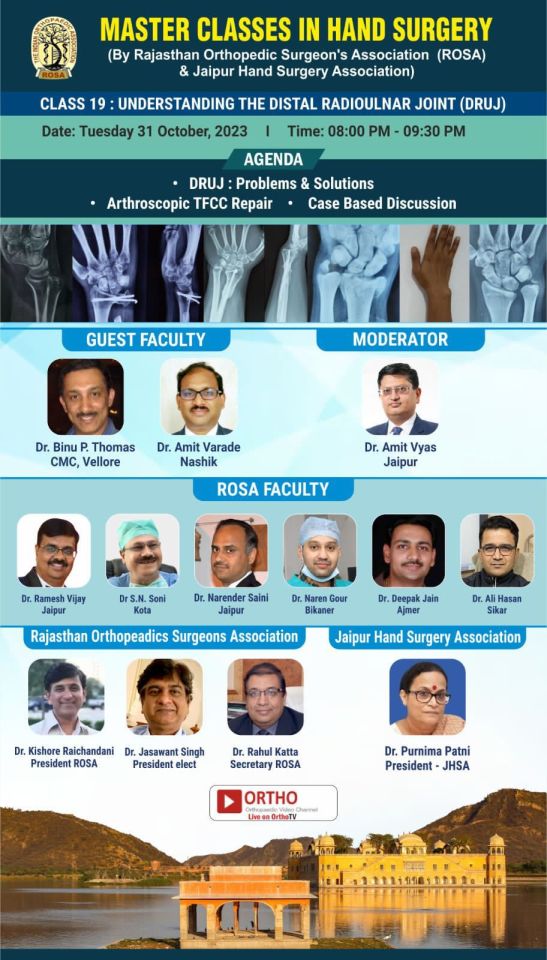
🔰MASTER CLASSES IN HAND SURGERY
🔆(By Rajasthan Orthopedic Surgeon's Association (ROSA) & Jaipur Hand Surgery Association)
🔆 CLASS 19 : UNDERSTANDING THE DISTAL RADIOULNAR JOINT (DRUJ
🔆Date: Tuesday 31 October , 2023
Time: 08:00 PM - 09:30 PM IST
🔆 Click to Watch : https://tinyurl.com/OrthoTV-ROSA-47
🔆AGENDA
DRUJ: Problems & Solutions
Arthroscopic TFCC Repair
🔺Case based discussion
👨⚕️ 🔆GUEST FACULTY
Dr. Binu P. Thomas CMC, Vellore
Dr. Amit Varade Nashik
👨⚕️ 🔆MODERATOR
��️Dr. Amit Vyas - Jaipur
👨⚕️ 🔆ROSA FACULTY
▪️Dr. Ramesh Vijay Jaipur ▪️Dr S.N. Soni Kota ▪️Dr. Narender Saini Jaipur ▪️Dr. Naren Gour Bikaner ▪️Dr. Deepak Jain Ajmer ▪️Dr. Ali Hasan Sikar
👨⚕️ 🔆Rajasthan Orthopedics Surgeons Association
Dr. Kishore Raichandani - President ROSA
Dr. Jaswant Singh - President Elect
Dr. Rahul Katta - Secretary ROSA
👨⚕️ 🔆Jaipur Hand Surgery Association
Dr. Purnima Patni - President JHSA
🤝 OrthoTV Team: Dr Ashok Shyam, Dr Neeraj Bijlani
📺 Streaming Live on OrthoTV www.orthotvonline.com
👨💻 Join OrthoTV - https://linktr.ee/OrthoTV
#HandSurgery#ROSA#JaipurHandSurgeryAssociation#OrthoTV#MedicalEducation#SurgicalSkills#Orthopedics#MedicalWebinar#DRUJ#ArthroscopicSurgery#OrthopedicSurgeons
0 notes
Text
youtube
Learn programming in 'C' by Deepak Jain in Hindi and Indian common language.
Subscribe to YouTube channel for more..
#tutorial#tutoriel#home tutor#online tutoring#tutorials#programming#c language#coding#programmer#coder#hindi#online tutorial#video tutorial#online classes#classes by deepak jain#tutorials by deepak jain#technology#consultant#developers & startups#discuss with deepak
1 note
·
View note
Text
DAY 5367
Jalsa, Mumbai Oct 22/23, 2022 Sat/Sun 1:00 am
Birthday - EF Kankana Chakraborty ... Deepak Jain ... Atul Kumar Shrivastava ... Monday, 24 October
.. and the greetings from the entire Ef family for your prosperity and love and care .. ❤️❤️❤️
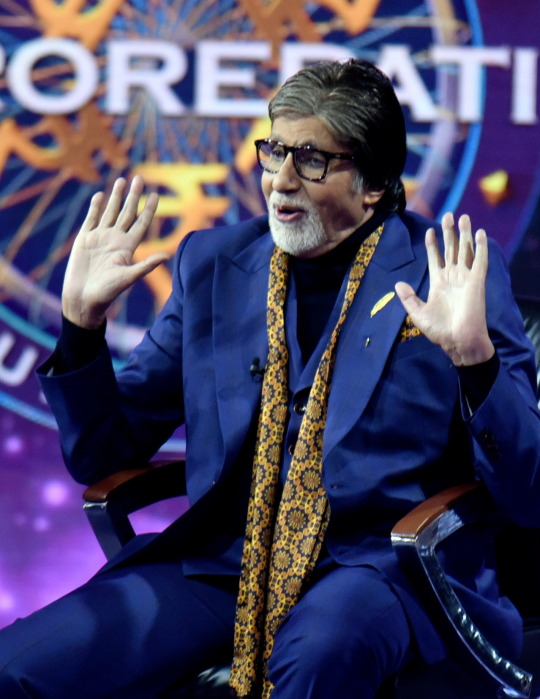
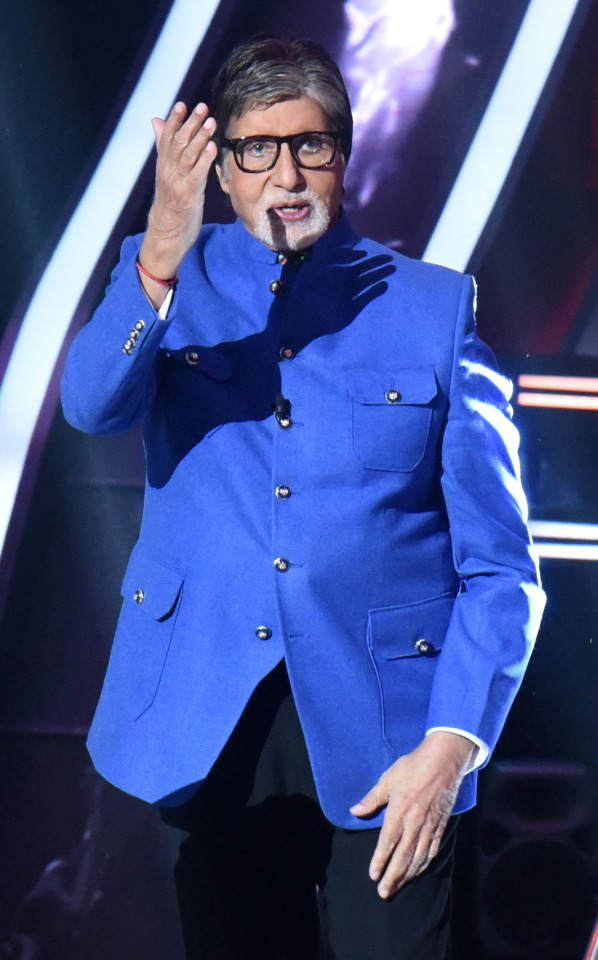

.. the lefty clap .. unusual .. but then ...

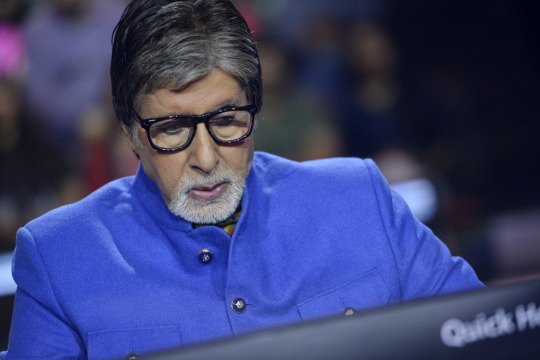
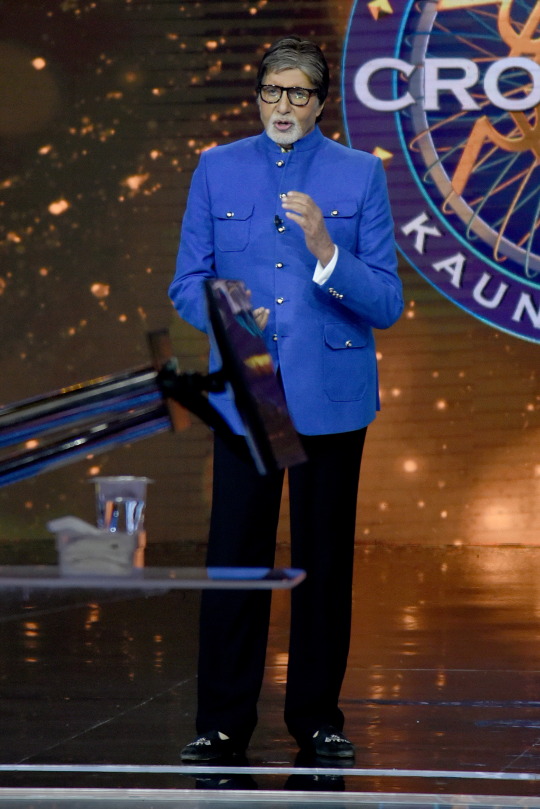
time and tide wait for no one .. the discouraged , the ominous , the discharged the irrelevant need to be kept in abeyance and beyond reach .. the gracious near and dear, in celebration of festive brilliance ..
the lethargy of time waits for no one .. the tides of fortune are the precursor of betterment and prosperity ..
and the wishes that abound among all , be of such great value and meaning ..
and so does the occasion of the lights and the ‘diyas’ bring to us the gifts of many and the wishes of fulfilment and joy ..
bringing credence to all in one quick swift response is humanly impossible .. but it shall happen with time ..
time though gave a young lady contestant at the ‘quarters’ of KBC an anxiety and the lines of not just despair, but of a sarcastic satire in content that it became important for me to publish it as was publicly promised from the seat of KBC power :
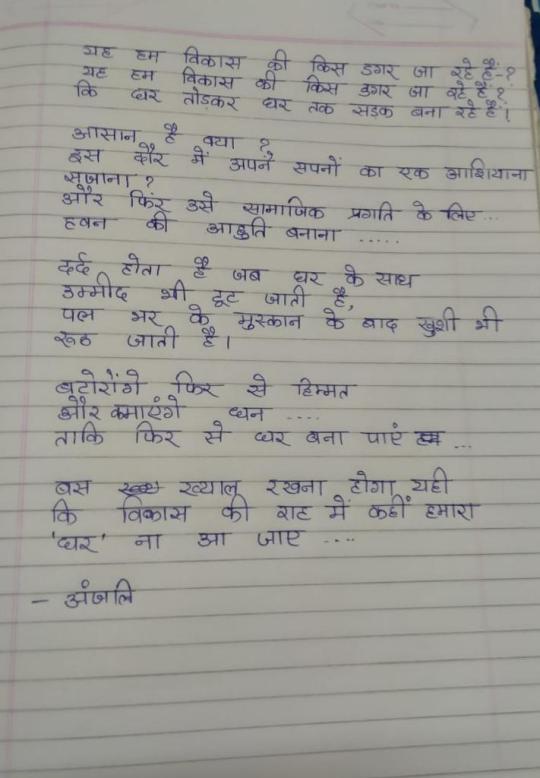
a young promising lady who had built a gentle 2 storied home for herself and her family one fine day due to an order by the Authority, ran a pass road through it destroying the house that she had built with love care and affection ..
she wrote the above .. ☝🏽
and asked me to read it out on the platform .. I did .. and finding it very close to me promised her that the content would be displayed on my Blog .. so there ..
( the Hindi geniuses may please enlighten the audience with its translate )
.. and somewhere it strikes a chord .. a personal chord ..
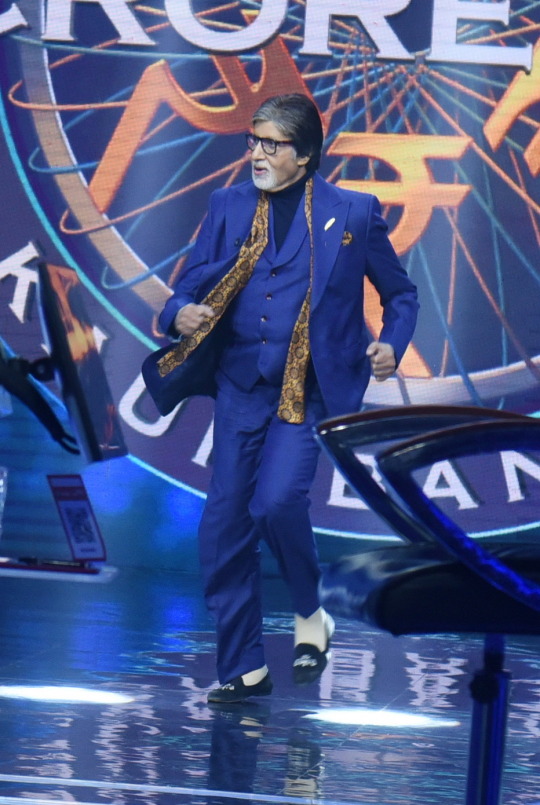

some of best performances get their due on the stage of the floor where the curtains dare not go down .. so injury or no , the SGO .. nnnn
a jutting piece of metal sliced my left calve and managed to cut the vein .. the vein when cut spurts out the ‘red’ uncontrollably .. but had the nerve to get the doc and so into an OT and the stiching up .. with the assistance of team of staff and docs in time ..
the throb is the control factor on kBC and it must be stated that those 3-4 hours on each episode, does take care of the ... aahhh never mind .. !
its a little inoperative, but the will to continue in the similar spirit of measurement and tribe and class in range does give a hope and we cope ..
its quite fresh and with opinion and advice ..
now the detaining may not be of mention else where , from all of you .. so do help ..
the coming days bring the relief of festive lights and a resurgence of emotion and more .. but for the men to be doing that is always a bit unfair ..
pardoń !!!
but in admittance the medical to not stand , to not move, to not strain on it by even a TreadMill walk is not permitted !!
at times the satisfaction of the extreme may bring the joys or the griefs of existence .. but extremes do not and never last .. they either perish or leave an indelible mark .. at strategic places on the body or bodies .. that is an embarrassment .. takes a while to step out of it , so help me God .. !!!
there is conjecture .. and there is the sudden appearance of the invited .. and then the reason for the making of the human .. and many other .. unfair to the straight and correct .. fair to the other ..
aaahhhhh .. the ‘other’ again .. and there is large portfolio of this soon ..
but on some other day ..
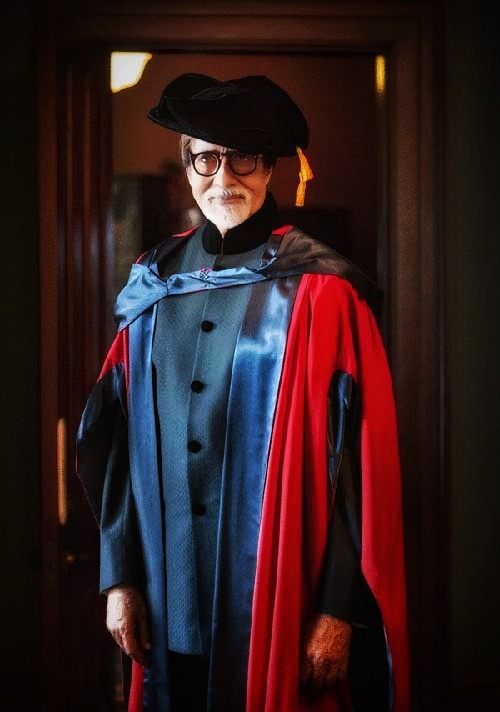
.. the doctor .. err apologies ... the dr in Austria .. on the University of Study at Australia .. a sneak peak into the lives of strange strains .. virtually and in the command of the future ..
.. they be and be not ..
and life moves on .. and on and on ..

Amitabh Bachchan
💜🪔 , October 23 .. birthday greetings to Ef Atul Ahluwalia .. and Ef Sonia Ahuja .. praying for the Lights of the Divine to burn every evil without and within .. prayers for peace and safety .. 🙏🏻✨
140 notes
·
View notes
Text
Dishonour of cheque: Legal and moral wrong
What an author likes the most to write is his signature at the corner of a cheque, but what if that cheque returns back?
A cheque is a piece of paper containing in writing a right entitling the holder to claim something, usually money, but sometimes goods. It’s also known as bill of exchange drawn on a specified banker and not expressed to be payable on demand including an electronic image of a truncated cheque and a cheque in electronic form.

Important Terms:
• Author of the cheque: Drawer • The person in whose favour the cheque is drawn: Payee • Bank from where funds to be transferred: Drawee bank
Dishonour of cheque:
Cheque bounce is a slang used when a cheque is returned from the bank due to any reason like non-tally of signatures, stale cheque and insufficient funds in the account (an offence). The drawee bank instantly issues and sends a ‘Cheque Return Memo’ to the banker of the payee on dishonour of cheque mentioning the reason of the same. Lastly, the payee’s banker will return the bounced cheque and the cheque bounce memo (a receipt of information) to the payee.
Passing bad cheques can be illegal, and the crime can range from a misdemeanour to a felony. Sec 138-143 of Negotiable Instruments Act deals with dishonouring of cheques which are considered as an offence.
Essentials to attract sec 138 of act:
• Dishonour of cheque • Payment in the discharge of debt/liability • Presentation of the cheque within the validity period(6-months) • Dishonour due to insufficient funds etc. • Element of dishonesty • Notice and demand from the drawer within 30 days of receipt of the information • Non-payment by drawer within 15 days from the receipt of the notice
Sec 13(1) of the Negotiable Instrument Act Sec 6 of the Negotiable Instruments (Amendment) Act, 2002 enlarging the definition of the cheque. In Devendra Singh v. Varinder Singh M.P. high court considered the dishonouring of cheque under sec 138 where the signature of the drawer was different from the bank records. When a cheque gets expired i.e., after 6 months from the date of issuance. Sec 138 of Negotiable Instruments Act.
Legal remedies
Following are the important things to avail legal remedies provided for bounced cheque:
• The complaint should be filed in the court of Judicial Magistrate of First Class or Metropolitan Magistrate (MM). within:
30 days from the receipt of the reply to notice; 30 days after the expiry of 15 days from the date the notice was sent in case of no reply.
• If the payment by way of the cheque is made as gift or charity, it doesn’t attract sec 138 as payment is not for legally enforceable debt/liability.
• If after the receipt of the notice, the cheque is presented at the bank on the instance of the drawer of the cheque and results in dishonouring again it doesn’t extend the timeline of the drawer as provided in the notice. • Dishonestly stopping the payment of the cheque issued by drawer comes within the ambit of sec 138. • Dishonour of mutilated cheque doesn’t comes u/s 138. • The drawer can be awarded the punishment for imprisonment up to 2 years or with fine twice the amount of the cheque or with both.
A person faces great hardship if a cheque issued in his favour is dishonoured. So utter carefulness while discharging one’s legally enforceable debt/liability should be taken.
Uplanche v. R.K. Vimala, 1998 (A.P. High Court) Electronics Trade Ltd. v. Indian Technologist Pvt. Ltd., A.I.R. 1996 S.C. 2339 Deepak Aggarwal v. Ram Swaroop Jain
Get In Touch Ricky Chopra International Counsels
Best Law Firms in Gurgaon
Help Line: +91 88 008 55555, +91 11 45695555
#Best Law Firms in Gurgaon#Gurgaon Lawyer#lawyer#law firms#Dishonour of cheque Legal and moral wrong
1 note
·
View note
Text
Shri Venkateshwara University organized the Pre - Investors Summit workshop to promote the Global Investors Meet 2023.



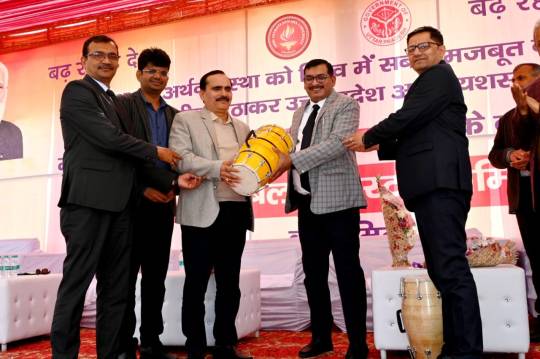
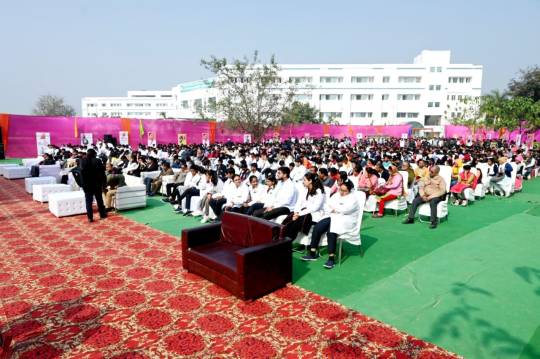
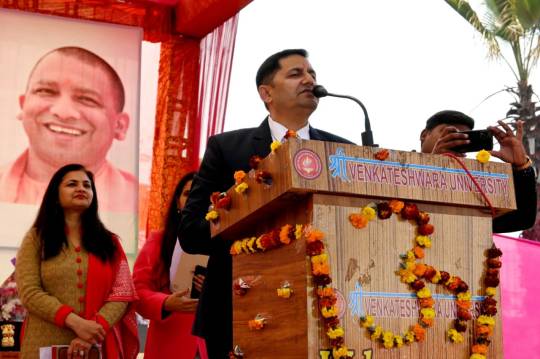
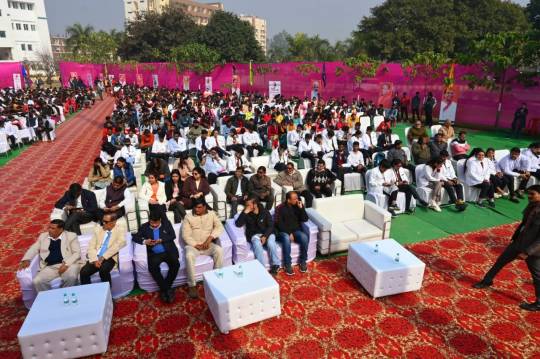

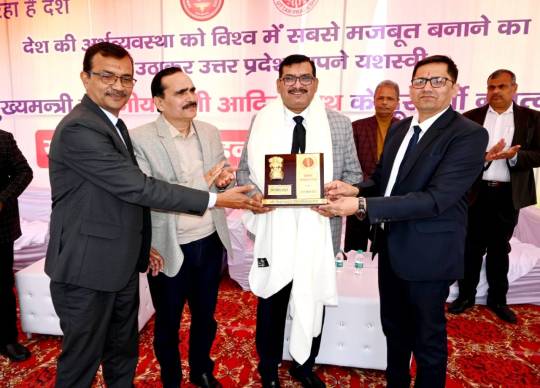
Shri Venkateshwara University/Institute, along with the Uttar Pradesh Government, hosted the Pre - Investors Summit workshop for promoting the Global Investors Meet 2023.
The Global Investors Meet 2023 will take place at Lucknow from Feb 10th for making India an economic superpower.
This meet will highlight our honourable PM mission of making UP the biggest contributor to India’s growth journey.
Over a dozen high-ranking officials of the UP Govt along with educationists & economists took part in the workshop & explained this ambitions scheme to make the nation strong.
Special Secretary UP Govt. Mr Neeraj Shukla, DM Mr. Balkrishna Tripathi, Keynote Speaker Dr B R Kukreti, & the Pro Chancellor Dr Rajiv Tyagi inaugurated the event by lighting a lamp to Goddess Saraswati.
The VC Dr Rakesh Yadav & the Registrar Dr Piyush Pandey assisted them in inaugurating the event.
The Group Chairman Dr Sudhir Giri announced the Venkateshwara Group will invest INR 500 crores in the next five years in education, healthcare & medical services.
In the presence of dignitaries, the special representative of Dr Sudhir Giri Dr Rajiv Tyagi presented a MOU regarding the investments.
Dr B R Kukreti stressed that through technically qualified professionals & excellent infrastructure, India has emerged as a global leader.
The global investors want to invest here as India offers world class healthcare & transport facilities.
UP will play a decisive role in India’s growth story.
Through excellent investment, India is spearheading to become an economic superpower.
Mr Neeraj Shukla stated that UP’s role will be primary in making India an economic superpower.
Mr. Balkrishan Tripathi highlighted India is fast becoming an economic power through world class education, healthcare, minerals, infrastructure & excellent transport services.
Those present included the CDO Chandrashekhar Shukla, ADM Mayaprakash, ADM Bhagwan Das, Agriculture Officer Rajiv Kumar, Industry commissioner Vikas Yadav & the district Inf. Officer S. Kumar.
Also present were Dr C P Kushwaha, CFO Vikas Bhatia, Dr Yogeshwar Singh, Dr Bora, Dr Baghel, Dr S N Sahu, Dr Mohit Sharma, Maroof Chaudhary, Arun Goswami & Dr Rajesh Singh.
Noticeable with their presence was the Meerut Campus Director Dr Pratap Singh, Alka Singh, Neha Jain, Rinki Sharma, Brajpal Singh, Deepak Kumar & Mayank Agarwal.
We acknowledge the efforts of our media In charge Mr. Vishwas Rana and others.
0 notes
Photo

India's capital sees surge in COVID-19 infections ahead of Diwali
India's capital has seen a surge in COVID-19 infections as pollution levels have soared to dangerous levels at the onset of winter.
The capital reported 8,593 new COVID-19 infections on Wednesday, its highest daily tally yet. The country of 1.3 billion people is second worst-hit behind the US.
The average pollution reading was 299 on Thursday on a scale of 500, where any number above 300 is classified as very poor and can cause respiratory illnesses.
Delhi Resident Varun Kaushik's 92-year-old grandmother started coughing and her blood oxygen levels plummeted on Wednesday. He took her to two top private hospitals in New Delhi on Monday. Neither took her in, even after one of them found that she tested positive for COVID-19.
Kaushik said several other hospitals told him and his family on the phone that they had beds available, but not in the intensive care unit (ICU) his grandmother needed. He finally admitted her to a non-ICU COVID bed in a government hospital, 10 hours after leaving home.
Her condition was stable as of Thursday, according to Kaushik.

The country of 1.3 billion people is second-worst hit after the US [File: Danish Siddiqui/Reuters]
The family's ordeal is a warning sign for a city where infections are surging even though they are dropping elsewhere in the country.
Delhi's 20 million residents celebrate their biggest festival, Deepavali or Diwali, this weekend. Despite a ban, thousands of fireworks are likely to be set off, increasing already bad air pollution and raising the risk posed by COVID-19.
'Diwali is looking like a super spreader'
ICU facilities in the city are in such short supply that some hospitals are squeezing more beds into existing wards ahead of the weekend.
“We are firefighting because Diwali is looking like a super spreader event in front of us and the public just doesn't see the threat,” said a senior health department official in Delhi, declining to be named.
New Delhi's sprawling bazaars have been swarming with shoppers ahead of Diwali, known as festival of lights, and the wedding season after the government relaxed regulations in a bid to breathe life into the lockdown-hit economy. Mask-wearing is common but physical distancing is not, and infections may spike in coming days.
We are firefighting because Diwali is looking like a super spreader event in front of us and the public just doesn't see the threat.
Health official in Delhi
The city was one of the first in the country to restart economic activity after the lockdown that started in March, letting restaurants, malls and other businesses open to avoid spiralling joblessness.
India has so far reported about 8.6 million coronavirus infections - the world's second-highest after the United States - and 127,571 deaths. But overall, it has been adding fewer cases daily since a mid-September peak, and its fatality figure of 92 per million people is well below the world's tally of 160 and the United States' 711.
Still, the state-run Indian Council of Medical Research says the recent fall in cases nationally could be undone if there is a resurgence in infections around Diwali.

Shoppers crowd a market ahead of the Hindu festival of Diwali, amidst the spread of the coronavirus disease [Adnan Abidi/Reuters]
Federal authorities have asked the local government in the capital to prepare resources to handle as many as 15,000 cases a day and test more aggressively.
ICU facilities in short supply
More than half of the city's 16,511 COVID hospital beds were occupied as of Wednesday, government data showed, with at least 24,000 other patients isolating at home. There is no separate data for ICU beds.
Delhi's government said hundreds more beds had been reserved for COVID-19 patients in nearly two dozen private and government hospitals. More than 100 ICU beds are also being added in government setups.
“Most of the cases are coming from working-class people, those aged between 20 and 50, those who are very active,” Delhi Health Minister Satyendar Jain told Reuters partner ANI, indicating these victims may not need critical care.
He did not respond to emailed questions from Reuters.
All ICU beds at Sir Ganga Ram Hospital, one of the top private hospitals in the city, are now occupied, said Dhiren Gupta, a senior pulmonologist.
In government-run Ram Manohar Lohia Hospital, doctors have packed beds into ICU wards to the closest permissible limit.
“We have increased the number of beds but there are limitations of distancing and ventilation,” said Desh Deepak, a senior pulmonologist. "We're operating at almost full capacity in ICUs."
Kaushik's experience with his grandmother has left him worried about himself and the rest of his family, as they wait to get tested for the coronavirus themselves.
"God forbid, if anyone else needs hospitalisation ... what would happen two days down the line?" he said. "That is even more scary."
. #world Read full article: https://expatimes.com/?p=13874&feed_id=16413
0 notes
Text
Will citizenship bill withstand legal scrutiny? Experts weigh in - india news

Does the Citizenship Amendment Bill (CAB) violate the spirit of the Constitution, a secular document that prohibits classification on the ground of religion? That is likely to be at the core of the legal challenge the proposed legislation will almost definitely face, with many political parties already indicating that they will take the matter to court. CAB amends the Citizenship Act, 1955 to allow Hindus, Sikhs, Buddhists, Jains, Parsis or Christians from Afghanistan, Bangladesh or Pakistan, who entered India before December 31, 2014, to apply for Indian citizenship. In the debate over the bill in the Lok Sabha on Monday, some opposition leaders expressed concerns that CAB violates Article 14 of the Constitution, which guarantees equality before law and says the State “shall not deny to any person equality before the law or the equal protection of the laws within the territory of India”. Some legal practitioners in the field of Constitutional law disputed Home minister Amit Shah’s argument that the bill allowed “reasonable classification” — the Supreme Court says reasonable classification must bear a reasonable and just relation to the sought object which is to be achieved by the legislation. Senior advocate Upamanyu Hazarika said CAB, as a stated act of legislative policy, was in breach of Article 14. “The government may justify it to say that Article 21 (right to life and liberty) is available to even those belonging to foreign lands but as a legislative policy it is an act of discrimination. Article 14 allows reasonable classification but not class legislation.” CAB excludes a class of people, basically Muslims, said Supreme Court advocate Gopal Sankaranarayanan. “It is patently in violation of Article 14 of the Constitution as it discriminates on the ground of religion. It also violates the right to belong to India as a citizen with dignity protected by Article 21.” Former Lok Sabha secretary general PDT Achary, too, was of the view that CAB is against the Constitution, which provides for citizenship not on the basis of any religious consideration. He said that it keeps out “one set of people in the name of religion”. “You are keeping Muslims out, but bringing in other religious groups. Citizenship law under the Constitution is secular,” said Achary. However, advocate Sai Deepak Iyer said he finds “no infirmities” with CAB and added that it neither suffers from any unconstitutionality, nor violates Article 14. The big legal debate is over reasonable classification. ”When you classify a certain group and favour them then you have to find a rationale basis for it, such as how that segment is different from the rest,” said Achary. “Here you are keeping the Muslims out, but how is the government justifying including the other religious groups? ?” “In specifically referring to Muslim majority Nations such as Afghanistan, Pakistan and Bangladesh, the provision makes it clear that all other type of refugees are permitted to take citizenship in India except the Mulsims. But there is no rationale basis to carve out such an exception,” echoed Sankaranarayanan. Iyer said the government has been able to justify that the migrants, other than Muslims, were persecuted groups in the neighbourhood where they were religious minorities and “persecuted for their religious affiliation”. “This satisfies the requirement of intelligible criteria, assuming that Article 14 can indeed be applied to someone who seeks to enter India for the purposes of grant of refugee status or citizenship,” he argued. Another legal argument is likely to be about whether CAB violates the basic structure of the Constitution. Sankaranarayanan said the provision sough to be included in the Citizenship Act, 1955 is blatantly communal. “ basic structure doctrine is the fundamental test to weigh a constitutional amendment. This bill goes to the core of constitutional values of equality and secularism. To withdraw the fundamental civil rights of citizenship in a different manner to those belonging to one community alone is completely rebel against the constitutional ethos,” he said. Achary, too, claimed that secularism is part of the Constitution’s basic structure – a doctrine propounded by the Supreme Court in 1973 in the Keshavanand Bharti case, which held while “Parliament has “wide” powers, it did not have the power to destroy or emasculate the basic elements or fundamental features of the Constitution.” Clearly, one way or the other, the court will have the last word. Source link Read the full article
0 notes
Text
Eminent minds in global design congregate in Delhi for DesignX Summit

14th September 2019; New Delhi: The biggest confluence of most sought-after creative minds from the global art, craft, architecture, and design industry are congregating for a two-day festival — DesignX — starting today. The confluence is being held in Hotel Taj Palace in Delhi. Leading the event is its Chief Curator — Padma Shri Sunita Kohli — India’s most celebrated interior designer and architectural restorer. She is supported by a team of curators comprising of eminent professionals including Art curator — Farah Siddiqui, Director, FSCA; Interior architecture curator — Kohelika Kohli, CEO and Creative Director, K2 India; Crafts curators — Rahul Jain and Gunjan Arora, Thread Artistes.
DesignX is a themed and microcosmic celebration of the FIVE SENSES through visual displays of the best of Indian design, Indian Art and Indian Crafts and its various tactile experiences. The event is presented by Jaquar Group and powered by A-Class Marbles. Times Strategic Solutions Limited is the organizer of the event.
DesignX will enable the participants to witness conversations with provocative speakers, live competitions, exhibitions, professional development sessions, experience zones, and face-to-face round tables with design heroes. The sessions will focus on the philosophy of FIVE SENSES and will discuss topics ranging from design for designers, design for all and beyond design. The event will be inaugurated by Dr. Karan Singh.
Speaking on the concept of DesignX, Padma Shri Sunita Kohli, Chief Curator, said, “Design since time immemorial has been a preferred way to express, communicate and connect by humans. India has a rich legacy — be it the ancient ruins of Indus Valley or the adorned temples of Varanasi or Gujarat to the scenic tombs of Agra and Hyderabad — design has been a sacred thread that has managed to bind diverse cultures and preferences into the very idea of India. The idea of DesignX is to celebrate the richness and diversity of art and design in everything we feel or see or live by. It is an honour to be in the company of such ignited minds across global design ecosystem and experience their perspectives. I am looking forward to two days of inspiration and insights.”
Commenting on the event, Deepak Lamba, President, Times Strategic Solutions Limited, said, “The Indian design industry was largely limited to the elite and at one point in time was synonymous to luxury. With the rise in purchasing power, global exposure and more and more entrepreneurs dedicated to create awareness and make design affordable — the industry is set to witness orbital shift in terms of growth. We at TSSL believe it is important to support and celebrate diverse industries that are witnessing a shift — as the process involves dialogue, collaboration and knowledge sharing and sustained innovation. DesignX aspires to be one such platform globally — uniting those who have the perspectives with those who have the resources and well as execution capability. This year we are honoured to have among us celebrated dignitaries to share their views and enlighten as well as enthrall the participants — thereby partnering our efforts to push India to the top of global design landscape in the coming years. We thank our partners, collaborators and teams to help us to present such an audacious dream. We look forward to successfully hosting the event in the next two days.”
0 notes
Text
Master Class in Hand Surgery
🧾Master Class in Hand Surgery: Rajasthan Orthopaedic Surgeons Association with Jaipur Hand Surgery Association presents Class 4: Lower End Radius Fractures : Current Concepts
🔺Wednesday 30th June : 7.30 pm IST: http://bit.ly/OrthoTV-ROSA-25
🔸Faculty: Dr Purnima Patni, Dr Hemant Patankar, Dr Amit Varade, Dr Vinit Arora, Dr Mohan Mantri, Dr Deepak Jain 🔸Moderators: Dr Amit Vyas, Dr Atal Soni
🔸ROSA President: Dr Arun Vaishya 🔸ROSA Secretary: Dr Rahul Katta
♦️Streaming on OrthoTV

0 notes
Photo

Buddhism was born under a giant fig tree, which, today, grows at the center of the remote and unbeautiful town of Bodh Gaya, in India’s destitute northeastern state of Bihar. The tree is about three crooked blocks from the Be Happy Café and a few minutes’ walk from a used book store where a middle-aged Krishna devotee from Iowa, named James, works, reselling old paperbacks by Hesse and Murakami.
The sacred Bodhi Tree is surrounded by a wall and guarded by police. (Islamic extremists bombed the site in 2013.) At dawn, before pilgrims begin their daily perambulations around the tree’s massive trunk, local children forage under its sprawling canopy—some branches are propped up by iron columns—to gather fallen leaves. Pressed inside clear plastic, the leaves are sold to visitors from Bhutan, Myanmar, and Manhattan, and to outposts of Buddhism around the world. The historical Buddha, Siddhartha Gautama, a reputed prince from what is now Nepal, is said to have achieved nirvana while meditating under the tree, in the fifth century B.C. The Awakened One purportedly spent seven weeks under the Bodhi Tree after achieving liberation from the wheel of suffering that binds humankind to selfhood, aging, disease, and death. So Deepak Anand told me.
Last winter, I met Anand not in the Be Happy Café but at one of its competitors, the Tibet Om Cafe. The menu offered a staple comfort food of Western spiritual seekers in Asia: banana pancakes. Anand, who was forty-five, didn’t eat. He was tall, pin-thin, had a shaved head, and was so intense and talkative that he ordered a cup of tea but forgot to drink it. Anand is a self-taught cultural geographer. For the past twelve years, he has analyzed historical texts and used G.P.S. technology to chart what he says are the pathways walked by the Buddha as he spread his philosophy of mindfulness across northern India, about twenty-four hundred years ago. Anand hopes to promote this spiritual legacy by reviving a network of “Buddha trails” for pilgrims and tourists to walk in Bihar, the cradle of the world’s fourth-largest religion. Yet Buddhism largely vanished from the region centuries ago, eclipsed by Hinduism and Islam. Today, farmers plow up stone effigies without realizing that the sculptures are antique representations of the sage. “People long ago tore down the stupas and built their homes using the old bricks and stones,” Anand said, referring to Buddhist monuments that once dotted the Ganges River plains. “They simply didn’t know.”
To test his ideas, Anand suggested we hike from the Tree of Enlightenment, in Bodh Gaya, to the ruins of the Nalanda university—an important center of Buddhist learning, which was razed by Turkic invaders in the twelfth century. The four-day trek effectively spans Buddhism’s rise and fall in the subcontinent—many scholars believe the university’s destruction contributed to the religion’s decline. No one in recent times, Anand assured me, had retraced the Buddha’s footsteps along the fifty-mile route.
The Buddha’s only concession to hiking kit was a begging bowl. He sometimes strode through the villages of Bihar with a large crowd of followers in tow. Our own walking party numbered four: the Bangalore-based journalist Bhavita Bhatia carried a Free Tibet flag in her rucksack; Siddharth Agarwal, a river conservationist from Kolkata, lugged a leaden hardback copy of “Ganges: The Many Pasts of an Indian River”; I packed the electronics needed to transmit stories from the trail. Only Anand practiced Buddhist non-attachment. All he brought was a light sweater. “Sorry, sorry, sorry,” he said, when we caught up with him on the trail, after he repeatedly surged ahead. “I’m a high-energy person.”
In the Buddha’s day, northern India’s religious landscape was in a time of spiritual crisis and social upheaval. Disillusioned, rudderless, Siddhartha renounced his gilded life—a childhood with thirty-two nursemaids, a kingdom with seasonal palaces and private gardens, and his princess wife and their child—to join other ascetics meditating in forests along the Neranjara River.
Today, plastic trash spangles the river’s sandy banks. Miles of rice fields steam where giant trees once threw blue shadows. “British records reported a leopard at the train station as late as the nineteen-thirties,” Anand said, wistfully. “It’s all gone.”
A carload of sightseeing Malaysian monks stopped to ask us directions. They ended up debating Anand about the location of Ratnagiri Rock, the site sometimes identified as the place where Siddhartha finally abandoned the hermit life, broke his fast with a bowl of gruel, and invented a “middle way” to transcendence that rejects both extreme sensuality and extreme austerity. Anand informed the monks that he had geotagged the exact coördinates of Siddhartha’s epiphany. The monks smiled in polite silence. “There are so many sects in Buddhism,” Anand said. “It’s impossible to convince them all.” We walked on. We passed the mountain cave where Siddhartha was said to have mortified himself for six years, by some accounts sleeping on a bed of spikes. And, after that pilgrimage stop, Bihar became just Bihar.
Chronically listed as one of India’s poorest states, Bihar isn’t usually associated with spiritual revival. Its news cycle instead tallies droughts, floods, fatal encephalitis outbreaks, and the violent aftershocks of a failed Maoist insurgency.
Following Anand, we plodded through abandoned sand mines. We stepped over railroad tracks. Inert villages slipped by, hollowed out by urban migration. In granaries, families hand-cranked large mechanical fans to generate a breeze for threshing their harvest. The Biharis, though, are ritually kind. They offer a cup of well water, a spot of shade, a narcotic betel nut to chew on the way. A day’s walk from the global tourist bubble of Bodh Gaya, where lamas broadcast meditation tips on YouTube, the world grows so insular that young village boys, peering up at me, exclaimed, “Look at that face! Have you ever seen a face like that?”
“What our people and the government don’t realize,” Anand told us, in frustration, “is that they are living on top of a global treasure—inside a living museum.”
Anand isn’t Buddhist. He was a Hindu by birth and is an empiricist by nature. Mostly, he is a proud Bihari.
The middle-class son of a military father and a housewife mother, Anand studied engineering and hoped to become a fighter pilot. But his curiosity kept drawing him to the mounds of Nalanda. The grassy hillocks are rubble from the powerful Magadha empire, whose kings funded the world’s first Buddhist monasteries, more than two millennia ago. Anand began poring through early travellers’ accounts of his homeland’s largely forgotten past. His hero is Xuanzang, an adventurous Chinese monk who travelled to India, in the seventh century, to study the roots of Buddhism. Working as a pilgrimage interpreter and cultural consultant, Anand became an unlikely Buddhologist. An entry on his blog, announcing his purported discovery of Ratnagiri Rock, and citing a fifth-century Chinese monk named Faxian, contains paragraphs like this:
According to Faxian the rock was 2 Li (400mts-700mts) north of the place where Sujātā, the village girl offered rice-gruel (milk-rice) to Siddhārtha. The place of offering food by Sujātā was 2 Li north of where Siddhārtha went to bathe-in river Nairaňjaňa. And, the bathing place was 3 Li west of the spot where Siddhārtha took austerities.
Anand has compiled hundreds of such waypoints in his Buddha-trail database. He is a keen admirer of his predecessors, the nineteenth-century British archeologists whose excavations proved that Buddhism was a South Asian idea. (Earlier scholars had maintained, based on curly-headed statues, that the Buddha was Ethiopian.) “The British were colonizers,” Anand said, “but they gave India the Buddha.”
“And they took everything they found away to London,” Agarwal, the river conservationist, said.
When we walked into a village called Lohjara, every household seemed to wave at Anand. He was hailed for pressuring the local police into investigating the theft of the village’s stone Buddha. The weathered statue, contemplating eternity in the lotus position, had been sitting in a local field for generations. In 2014, art thieves hefted the heavy sculpture into a car trunk and made off into the night. Two years later, acting on a tip, officers raided a nearby warehouse and found the Buddha packed for export. “We felt very bad those two years,” Rattan Pandey, a village elder, recalled. “We protested to the authorities to recover it immediately. We even blocked the roads.”
The restored Buddha was anchored with steel hoops beneath a village tree. The statue’s face was hacked off centuries ago, possibly by a Turkic soldier. Pandey worshipped the figure as Nakti Shiva, or Noseless Shiva, a mutilated version of the Hindu god.
We climbed the Jethian valley, plucking tart berries from jujube trees. According to the explorer-monk Xuanzan, a local man had tried to measure the Buddha’s height when he visited the place, but gauging the immense soul by any earthly means had proved impossible. In frustration, the skeptic had thrown down his bamboo yardstick—which sprouted to green life. Canebrakes still feathered Jethian’s high ravines. There were also faded village posters advertising Anand’s first effort at resuscitating the sacred landscapes of Bihar—a pilgrim’s walk organized with a charity from California.
A remote mountain road patrolled by rhesus monkeys led us to Rajgir, the former capital of the Magadha empire. The area was a bewildering Venn diagram of India’s singular spiritual history: Jain caves, Hindu temples, Muslim shrines, Ashokan stupas. Anand was well-known here, too. At Vulture’s Peak, a shrine where the Buddha taught his Heart Sutra—“Form is only emptiness, emptiness only form”—a crowd of touts, stevedores, rickshaw drivers, and cold-drink venders ringed Anand. They complained about being bullied by a pilgrimage mafia. He advised them to unionize.
On day four, we limped into Nalanda under clouds the color of polished lead. Anand showed us around. At its peak, Nalanda, in central Bihar, was the largest center of Buddhist learning in the world. It housed as many as ten thousand student monks. They argued about Buddhist doctrine and studied cosmology, astronomy, and art. Scores of villages nearby were dedicated to feeding resident scholars. Nalanda’s graduates helped carry Buddhism to Tibet and points along the Silk Road. “They used big mirrors to reflect light onto the Buddha statues inside temples,” Anand said, highlighting the monastic center’s architectural wonders.
But the manicured ruins felt comatose. Bhatia, the journalist, unfurled her colorful Tibetan pennant—the only touch of color on Nalanda’s barren squares.
How Buddhism ghosted away from its Indian source, between seven and nine centuries ago, remains one of the great mysteries in the history of religion. The Hindu nationalists now in power in New Delhi take an official stance: they insist that Muslim hordes from Central Asia—first Turkic invaders and later the Mughals—wiped out the pacifist Buddhists at sword-point. The general who razed Nalanda, Bakhtiyar Khalji, couldn’t even read the millions of Buddhist manuscripts he torched. But other scholars, Anand included, believe the reality is more complex. For centuries, Buddhism’s influence was waning in India. The monasteries created a brain drain, sapping innovation. The monks grew isolated from the people. Hinduism and Islam attracted more followers. It was as if Buddhism evanesced the same way that its master teacher did. The Buddha reputedly died, at age eighty, near what is today Kushinagar, in Uttar Pradesh. His ashes were taken from the scene of his life and scattered far across the Buddhist world.
According to some scriptures, the Buddha spent a week “walking a long way up and down in joy and ease” after attaining enlightenment. Our own little walking party sputtered to an end at the Nalanda bus stop. Bhatia left for Sikkim. Anand returned to his base, at Bodh Gaya. Only Agarwal and I slogged on—toward the Brahmaputra River. A dense ground fog hugged the fields, making navigation difficult. We stumbled along sodden canal trails. Crows appeared and vanished in the white. Anand had asked, before we parted, for endurance-walking advice. I’d forgotten to tell him that, on any long walk, he will get lost. And that being a little lost isn’t bad. It helps you stay awake. And being found is overrated.
—PAUL SALOPEK
0 notes
Text
Wargaming’s relaunch of the massively popular naval combat simulator for the market features India-specific content, custom pricing, and partnerships with leading industry players.
New Delhi, India, 18th September 2019 – Wargaming, the award-winning online game developer and publisher specialising in military free-to-play MMO titles, has announced the relaunch of the iconic World of Warships for the India market. World of Warships is a team-based massively multiplayer online action game featuring large scale naval battles in a selection of PvP, cooperative or competitive battle mode as well as historically inspired PvE scenarios and seasonal special events.
Since its launch in 2015, World of Warships has added over 30 million registered players on the back of its focus on history, military, and engineering enthusiasts, making it one of the most successful games in this genre on the planet. In a bid to continuously improve the gameplay and content, the company recently announced the arrival of submarines as playable vessels in addition to plans for the launch of the long-awaited ship class during gamescom 2019.
The company’s premier free-to-play naval combat game will now feature India-specific content supported by comprehensive partnerships with leading industry players including ACT Fibernet, Zotac, ANT Esports, and LG. The most exciting part of the India relaunch sees the company add content exclusively developed for the India market, including:
● National ship camouflages ● India-themed skin initially available only to Indian players ● Partner camouflages and flags ● Local language versions of their flagship content property Naval Legends, a video series about the most historically significant maritime moments of the 20 th century ● Additional content around the Indian Navy, museums, and ships
While all of these features will be available starting the 17 th of September, the company has also indicated the possibility of additional content such as thematic ports, containers, and patches in the near future, or even ships sailing under the Indian ensign.
To capitalise on the growing appetite for gaming in India, Wargaming has struck marquee partnerships with ACT Fibernet, Zotac, ANT Esports, and LG. The collaboration with ACT Fibernet will offer Indian players optimised routing to the EU server, a unique ACT Fibernet Camo skin available to ACT Fibernet customers, and up to INR 2000 worth monthly in-game benefits. Indian players on the platform will also have access to exclusive bundles from LG, Zotac, and Ant Esports.
This slideshow requires JavaScript.
Speaking about plans for the India market, Rajeev Girdhar, European Publishing Director for World of Warships and India Operations Lead, said, “We are immensely excited to be relaunching World of Warships for the India market. The country’s knowledgeable and curious gamer base provides an excellent audience for detail-oriented strategy games like World of Warships and we are excited to bring them a customised experience. We only see the exponentially growing appetite for immersive gaming in the country getting bigger, and that’s great news for new genres. Our belief that this is a substantial market set to explode has led us to build and develop a whole new range of immersive content that augments the already exceptional gameplay.”
Talking about the synergy between ACT and great gaming experiences, Ravi Karthik, Head of Marketing, Atria Convergence Technologies Ltd said, “ACT Fibernet is known to provide the best gaming experience with high speeds, low latency and packet losses. With the gaming industry in India now beginning to grow, we believe our proposition of a gaming pack that puts together in one place what the customer wants – speeds, data, low pings, in-game benefits and offers will meet the needs of gamers and enable a delightful gaming experience. We are extremely excited to partner with World of Warships for their India launch. The rich multi-player experience with strategies and quasi-real battles provide for great gaming experience which can be enjoyed by diverse age groups. Together we will work to build gaming in India and World of Warships to a huge success”.
In addition to ACT Fibernet, Wargaming’s partnerships with some of the country’s leading gaming product companies like LG, Zotac, and Ant esports are another reason for excitement. Samar Deep, Product Marketing Manager IT, LG Electronics, India, says “We’re very excited to partner with World of Warships, the perfect game to highlight the advantages of LG Ultragear Gaming Monitors, especially our popular lineup of Ultrawide monitors“.
Deepak Gupta, Country Head, India, at ZOTAC also announced the launch of India-specific bundles, stating that, “As the market leader in India, we’re glad to be the first to officially offer India specific bundles for our range of ZOTAC Gaming GPU’s starting from GT 1030 series going up to GTX 16 Series“.
The list of partnerships is nicely rounded off by gaming peripherals company Ant esports. Himanshu Jain, Director at Ant esports believes that the company’s existing user community will provide great support for new developments such as special edition products and bundles, saying, “We’ve been overwhelmed by the community’s response to our latest lineup of products that have disrupted the market and now we’re moving forward with collaborations with World of Warships for not only bundles but also Special Edition products early next year for our ever-growing community“.
The World of Warships India model will continue to operate on its free-to-play, pay-to-progress framework where players can enjoy the game for free while making small investments to unlock additional content faster. Cognizant of India’s price sensitivity, Wargaming will customise in-game pricing for the local audience, following our experience of entering new markets and best practices for connecting with the Indian audience.
The Cyprus-based Wargaming, founded by Belarussian chess prodigy Victor Kilsyi, is a world-leader in historically accurate MMO combat games by both popularity and profitability. Inspired by Mr Kilsyi’s obsession with military history and strategy games, the company boasts over 200 million registered users drawn to their combination of stunning graphics, incredible attention to detail, and immersive gameplay. Its concerted foray into the India market is set to be another milestone in the company’s stellar journey.
Head over to worldofwarships.in now to sign up for World of Warships for free.
WarGaming teams up with ACT Fibernet for new stuff Wargaming’s relaunch of the massively popular naval combat simulator for the market features India-specific content, custom pricing, and partnerships with leading industry players.
0 notes
Text
Pen Drive Classes and Video Lectures for CA Final, CS & CMA

As we all are aware of the course CA and the busy schedule of a CA Students, so the concept of Pendrive Classes for CA Final is the best option for them. There are many advantages of Pendrive Classes like
• You get the freedom to decide your own timetable to view the lectures. Actually, you are carrying it on your laptop and whenever you get free time, you can view it.
• You will never miss the lectures due to office commitments, ill health or social commitments etc.
• There is no fear of missing the lecture and due to which missing the link of next lectures.
I m a CS Final student just cleared my 2nd group in the last attempt, I think all the CA Final student is facing the same problem what I have suffered in past few years i.e. 3 years of articles does not allow so much time so that you can complete your batches in given time and most of the time I have missed my batches due to outstation audit and recovery of all the classes were very difficult. Then I got to know about “Smart Learning Destination” pen drive classes for CA, CS & CMA for all subjects at all levels by India's best faculties. I purchased the pen drive classes for CA final, it is very convenient to carry your classes wherever you want and you can watch your lectures whenever you want.
Earlier it was very difficult to get quality teachers for each subject due to limited resources but now Pendrive Video Lectures for CA, CS, and CMA by certified CA faculties and quality teachers at SMART LEARNING DESTINATION like Praveen Jindal, Sarthak Jain, Jai Chawla in FR, for law Darshan Khare, for SFM Praveen Khatod and Tarun Mahajan, for audit Aseem Trivedi and Aarti Lahoti, for cost Satish Jalan, Praveen Khatod, for direct tax Bhanwar Borana and Ashish goyal, for IDTL Vishal Bhattad and Deepak Gupta, for ISCA Jignesh Chheda, Bhavana Garg….they all are India's best faculties. Pen Drive Classes are very beneficial, you can increase the speed (if you want), there are multiple views available you can watch the Pendrive classes for multiple time and now it is available at all levels of CA, CS & CMA like inter, Foundation, IPCC, CPT, SMART LEARNING DESTINATION works on the concept of “how can we best serve the people that matter the most” as it is run by ca final students.
#PEN DRIVE CLASSES FOR CA#PEN DRIVE CLASSES FOR CS#PEN DRIVE CLASSES FOR CMA#PEN DRIVE CLASSES FOR CA FINAL#smartlearningdestination
0 notes
Photo

New Post has been published on http://www.visionmp.com/sharma-got-a-total-of-1531-votes-while-former-test-cricketer-madan-lal-could-only-poll-1004-votes/
Journalist Rajat Sharma is new DDCA boss, RTI put on hold
New Delhi: Senior journalist Rajat Sharma on Monday beat World Cup winning India cricketer Madan Lal by 517 votes to become the new president of Delhi and Districts Cricket Association.
The results of the DDCA polls were announced on Monday and Sharma’s group swept the elections, winning all 12 seats.
With DDCA being the first among equals to go into elections after the Supreme Court appointed Lodha Committee suggested path-breaking structural reforms, the polling also witnessed abolition of proxy system with nearly 3000 voters turning up to cast their vote.
Sharma got a total of 1531 votes while former Test cricketer Lal could only poll 1004 votes. The third candidate in the fray, advocate Vikas Singh, got 232 votes only.
In another major development, the new body will revisit the decision to have DDCA under Right To Information ambit as per Law Commission’s recommendations.
“I will try my best to uphold the democratic traditions of DDCA,” Sharma told mediapersons after accepting the charge from Delhi High Court appointed administrator Justice Vikramajit Sen.
While Justice Sen had brought DDCA under RTI ambit, the newly elected body is unlikely to toe the line and a meeting will soon be held to revoke the administrator’s diktat.
“The BCCI is not under RTI and DDCA doesn’t get any government grant. And why did Justice Sen just before leaving think about getting DDCA under RTI ambit? Why didn’t this cross his mind during all these months when he was taking policy decisions. We will certainly not come under RTI,” secretary Vinod Tihara said.
Coming back to the elections, it was a major setback for BCCI acting president CK Khanna, whose wife Shashi lost the vice-presidential battle against Rakesh Bansal, younger brother of former DDCA president Sneh Bansal, who was charged with round tripping of association funds during his time at the helm.
Rajesh beat Shashi by 278 votes while Bansal junior got 1364 votes to Shashi’s 1086 votes.
The defeat might prove to be the end of the road for Khanna in DDCA, where he enjoyed supreme power for nearly three decades.
Sharma and his panel’s candidature was backed by a political heavyweight from the ruling party with the IOA president Narinder Batra throwing in all his might. Batra incidentally is a former DDCA treasurer.
“The moment Sharma got blessings from a senior cabinet minister, there was no chance in hell for any other candidate to win this election. What was not expected was a clean panel sweep. It will be good that Sharma will get a free hand to run the body. This also means that CK Khanna’s reign in DDCA ends unless he strikes some deal with Sharma,” a senior DDCA official told PTI on conditions of anonymity.
Sharma was always considered as the favourite to win against Lal, who was backed by Khanna and former India opener Chetan Chauhan’s group.
Among the other notable winners was former sports committee head Vinod Tihara, (1374 votes) who became secretary defeating nearest rival Manjeet Singh (998) by 376 votes.
Tihara is expected to run the daily affairs of DDCA including a big say in all the representative teams – especially Ranji Trophy and men’s age group.
The joint secretary’s post went to Rajan Manchanda (1402), younger brother of former treasurer Ravinder, who beat Pushpender Chauhan (953) by 449 votes. Pushpender is the younger brother of Chetan Chauhan.
For treasurer’s post, Om Prakash Sharma beat Deepak Singh by 1241-891 votes.
Sanjay Bhardwaj was elected for the director’s post (first-class cricketer) while Renu Khanna became the women director.
The other directors elected were Apruv Jain, son of former media manager Ravi Jain, who polled 1286 votes, Alok Mittal, Nitin Gupta, Shiv Nandan Sharma and Nitin Agarwal.
0 notes